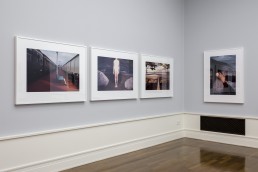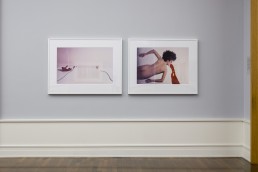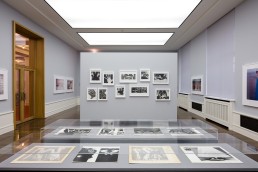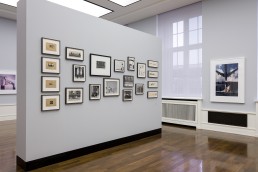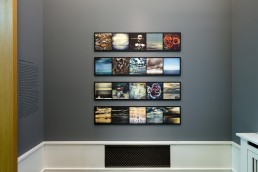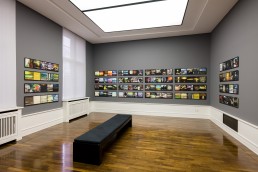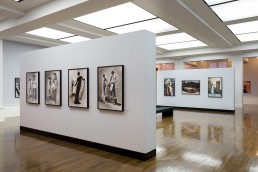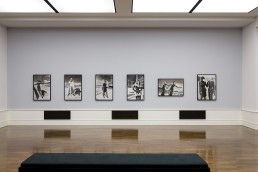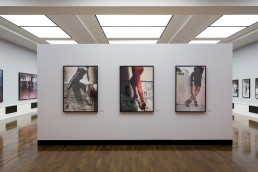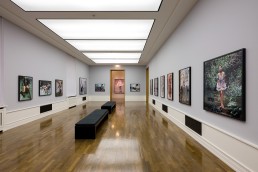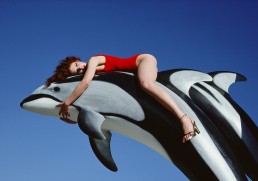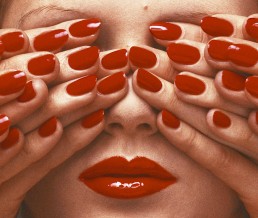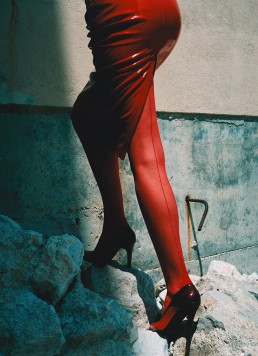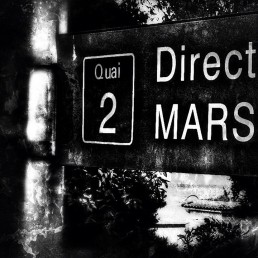Photography, especially fashion photography – which describes and constantly redefines the zeitgeist – aims to tell exciting and surprising stories with images. Bourdin and Newton mastered this task perfectly.
Guy Bourdin and Helmut Newton revolutionized fashion photography in the 1960s and 1970s. Both of them worked for the same magazines as well as directly for clients from the fashion world. They both achieved a sense of timeless elegance in their photographs, and each independently established an own “radical chic” aesthetic. Now for the first time ever, these two influential fashion photographers will be showcased together with selected commissioned works.
Image Maker presents exemplary works by Guy Bourdin for various publication contexts, notably his iconic and imaginative advertising images for Charles Jourdan shoes as well as lesser-known works, vintage prints, and layouts from French Vogue. Helmut Newton’s A Gun for Hire presents mainly commissioned works from the 1990s for fashion houses such as Thierry Mugler, Valentino, and Blumarine and for companies including Absolut Vodka and Villeroy & Boch. Initially presented in the brands’ own publications, some of these images were later enlarged by the photographer and incorporated into his own œuvre.
Small and intimate, “June’s Room” at the Helmut Newton Foundation is reserved for friends and colleagues, this time for Helmut Newton’s former assistant Angelo Marino. Complementing the works of Bourdin and Newton, Marino offers a highly individual view of his immediate surroundings under the title Another Story, featuring snapshot-like portraits and landscapes in surreal colors.
Selected Works
Bourdin – Newton – Marino
Matthias Harder
In the 1960s and 1970s, Guy Bourdin revolutionized fashion photography just as radically as Helmut Newton did. Both photographers worked for the same magazines such as French Vogue, and also worked directly for clients from the fashion world. In addition to capturing a timeless elegance in their work, they each developed the idea of “radical chic” independently of each other. Now for the first time, commissioned works by these two influential fashion photographers are being shown together at this extensive exhibition in Berlin.
In 1970s at the peak of their career while they photographed magazine editorials, Newton shot the collections of clients such as Chanel, Yves Saint Laurent, Thierry Mugler, Mario Valentino and Blumarine. Simultaneously, Bourdin photographed collections such as Versace, Ungaro, Chloe, Chanel and Yves Saint Laurent while in addition he found a prime client in Charles Jourdan, a French shoe brand, that lasted over 15 years.
Newton ironically called himself a Gun for Hire – the title given to the exhibition of his commissioned work from the 1990s, which was shown posthumously in 2005 in Monaco, Berlin, and later in Budapest. A selection of Newton’s later works is now being shown again at the Helmut Newton Foundation – juxtaposed with Bourdin’s earlier work. Their fashion photographs sometimes appeared in the same editions of Vogue, Harper’s Bazaar, and French Photo and also successively in the annual calendar of the camera manufacturer Pentax.
Under the exhibition title Image Maker, a selection of around 100 photographs by Guy Bourdin from these various sources will be shown. Divided into three parts, Image Maker addresses three aspects of Bourdin’s work: neo-surrealist and narrative creation as well as the photographer’s role as his own art director. Starting in the late 1960s, Bourdin was best known for the novel, idiosyncratic shoe photographs he shot for full-page advertisements published in fashion magazines. He depicted Charles Jourdan shoes in unusual locations and surprising configurations – showing for instance, two life-sized legs wearing shoes. Today, Bourdin’s avant-garde fashion photographs resound beyond their original commercial context as iconic images of the 1970s. When it came to the style and composition of his fashion images, Bourdin did not distinguish between advertising and editorial campaigns. In some cases, he relegated his female models to the periphery of the image in order to shine the spotlight on Jourdan’s shoes.
His visual language reminds us of the experimental and at times disturbing images of the Surrealists, whose work Bourdin seemed to translate for a contemporary audience. His approach was characterized by the use of off-beat portraiture and fashion locations, meat markets, for example, the arrangement and collage of highly disparate objects, and the incorporation of mirrors for a doubling effect or glimpses into a metaphysical parallel world. Bourdin made use of such Surrealist techniques in his early black-and-white photographs and in some of his later fashion images as well. He further confounds us as viewers with his image-in-image situations that stratify the pictorial space and his working process into multiple levels, making them seem four-dimensional.
We find an example of his mysterious and uncanny visual language when he directs our gaze to the corner of a white room where the floor, baseboard, and wall comprise a miniature stage. On the left side of the frame is a single red shoe, whose compact sole curves up to the heel to create a summery, elegant wedge sandal. The shoe is placed at a slight angle close to a wall socket, into which a green power cord is plugged, bringing a thrilling complementary contrast to the image’s otherwise reduced color palette. Equally unusual are the emptiness at the center of the image and the artificial blood or nail varnish oozing from the holes of a second electrical socket. Bourdin was the only photographer who dared to stage such disturbing, minimalist scenarios for the fashion world at the time – and who also had a carte blanche from his client to do so. Bourdin created images that, once they are seen, inscribe themselves irrevocably into our memory.
Helmut Newton is likewise known for his frequent use of the shoe as a motif – black high heels in particular. As we can see in the current exhibition, they hold the feet of Nadja Auermann, for example, clad in dark, semi-transparent stockings. In one photograph her legs end at the thigh, just below the hem of a simple short black dress. In a second shot they disappear under a short white gathered dress that is partly hidden behind the long veil of a matching hat. Newton photographed the German supermodel for the exclusive Italian brand Blumarine several times in 1994 in Monte Carlo, including near its famous marina. In these images, she is pictured from below, making her long, slender legs look even longer. The model stands on a plain concrete surface; in one shot we look with the photographer inland towards the harbor and casino; in the second, obviously opposing, shot we look out towards the sea. While Newton identifies the location in the first image, he obscures it in the other with a simple shift in perspective. Smiling into the camera, his model looks down at her viewers from her elevated position. Meanwhile her hands, as is so often the case in Newton’s fashion photographs, are posed with the fingers slightly spread apart.
These motifs can be found in the exhibition space as life-sized prints, a format we already know from Newton’s Big Nudes project. During the 1990s, Newton played with unconventional picture formats in his fashion photography as well. A further peculiarity is apparent only at second glance: the black stilettos are a bit too large for Auermann’s feet. The photographer doesn’t hide but rather emphasizes this detail through the parallel positioning of her feet, as if to underscore this general “system error” of the fashion business. The black evening shoe is presented as pure form, pure elegance, and for some viewers possibly a fetish object. In another photograph, Newton transformed a shoe designed by Walter Steiger into a meter-high object by enlarging the image to several times its original size. Through its monumentalization, he endows it with an erotic, almost menacing effect.
In A Gun for Hire we see images that were mainly commissioned by fashion designers and which were first published in their fashion books; Newton later presented some of these images as part of his oeuvre. It was never merely a fashion shoot that he produced; they were often interwoven with a parallel narrative, sometimes tinged with a sense of surrealism or the suspense of an Alfred Hitchcock film. Frequently it remains unclear where reality ends and the staging begins, as the elements combine to create a confounding play of power and seduction.
For his later fashion and product commissions Newton often shot photographic sequences. Examples include his black-and-white visual narrative for Villeroy & Boch (1985), a color series with Monica Bellucci in different dresses by Blumarine (1998), as well as several motifs for a sports magazine calendar (2002) – in the latter case, the young bikini-clad women were not pictured as usual at the beach, but in the desert. The various series presented in this current exhibition are complemented by single images Newton shot for the German, American, Italian, French, and Russian editions of Vogue, primarily in and around Monte Carlo. He depicted some of his models in the garage of his own apartment building in Monaco, occasionally staging them in dialogue with the cars that were parked there. Newton transformed banal locations into starkly contrasting or particularly minimalist theatrical stages for his unconventional scenarios.
Fashion photography – which describes and constantly redefines the spirit of the times – aims to tell exciting and surprising stories with images. In this respect, Bourdin and Newton mastered this task perfectly.
Small and intimate, “June’s Room” at the Helmut Newton Foundation is reserved for friends and colleagues of the Newtons – this time for Helmut Newton’s former assistant Angelo Marino, who has also worked with Newton’s widow June (alias Alice Springs) since 2004. Complementing the works of Bourdin and Newton, Marino offers us under the title Another Story an eclectic view of his immediate surroundings with snapshots of fellow travelers, the sea, the passing architecture or landscape as seen from the train window during his daily commute from his home in Cannes to his workplace in Monte Carlo. Marino’s images, shot with an iPhone, include amusing, bizarre, and everyday situations presented in surreal colorfulness. The square picture format and the vibrant colors in Marino’s images are reminiscent of the legendary SX70 Polaroids that Helmut Newton used for decades to sketch his ideas and compositions, which he later considered to be independent works in their own right.
Marino has arranged his photographs into 52 elongated tableaux, each consisting of five color images to represent one week of the year, with 260 images in total. In “June’s Room” the images’ shifting lighting conditions capture the change of the seasons, while each individual picture characterizes and symbolizes a day and the journey from one place to the next. Together they manifest a state of being on the road in subjectively chosen, fleeting fragments of everyday life.
Angelo Marino is a quiet and precise observer of his environment. As a long-time assistant of Helmut Newton, who continued to use analogue and non-digital photography in his later work, Marino’s series of mobile phone images enhances the current exhibition by the addition of a new technological aspect. Another Story is an associative sequence, a modern photographic road trip that is narrated with atmospheric visual details. Rich in the variety of both their form and content, Marino’s images give us the impression that reality, transformed into a digital backdrop, is passing us by.
